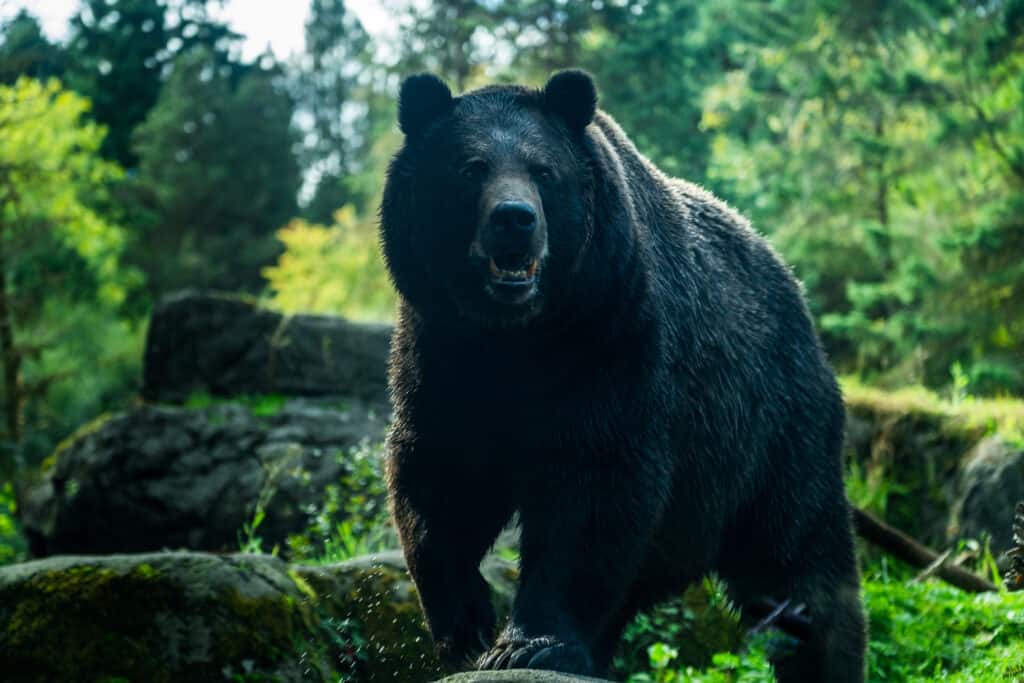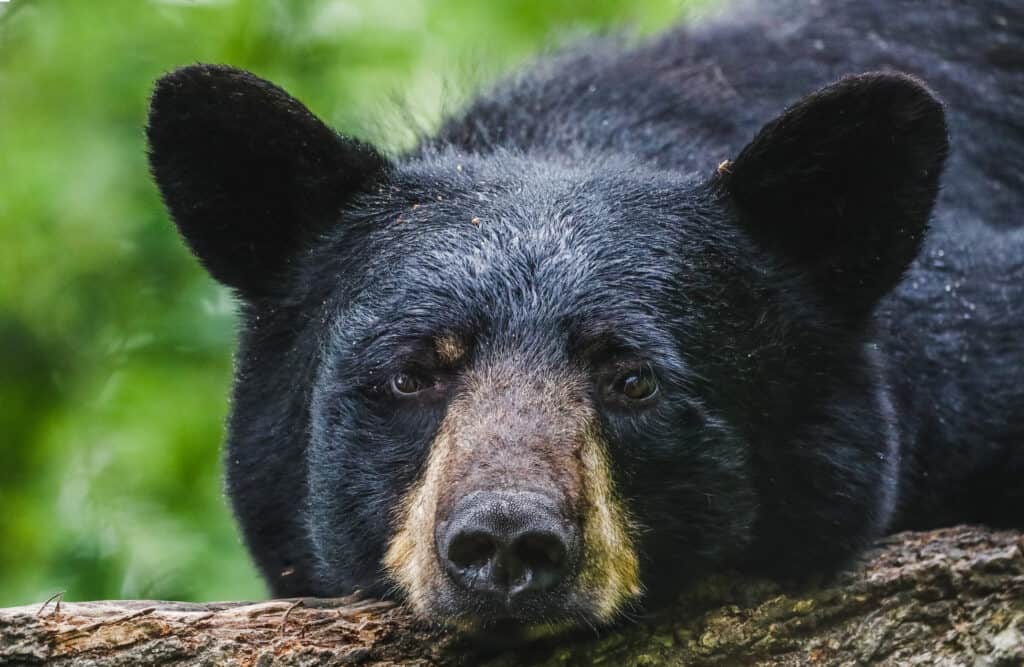The state of New York is perhaps most famous for its iconic, identically-named capital city. However, it also contains areas rich in natural beauty. Some of these areas have thriving populations of black bears, which occasionally appear near human habitations. They also have populations of hunters ready to take advantage of the annual hunting season. Read on to discover the largest bear ever caught in New York!
The Largest Bear Ever Caught in New York

In New York, the largest bear ever caught in New York weighed 684 pounds.
©elena_prosvirova/Shutterstock.com
The largest bear ever caught in New York was a black bear weighing 684 pounds. It was caught alive rather than killed in a hunt. However, the largest bear reported in the state weighed approximately 750 pounds. These individuals significantly exceed the typical maximum weight of adult male black bears, which is around 500 pounds.
In October 2017, hunter Dakota Relyea killed another massive black bear with his crossbow. At the time, it was thought to set the record for the largest bear in the state killed with a bow or firearm. The New York State Big Buck Club, a record-keeping body, recorded the bear’s skull measurements as 22 13/16 inches. This exceeded both the previous bow record of 22 6/12 inches in 2009 and the previous firearm record of 22 7/16 in 2011. Relyea’s kill had a body length of eight feet one inch.
The largest black bear in the world came from the province of New Brunswick in Canada. Its live weight was 1,100 pounds, which came to 902 pounds dressed. It stood 7.9 feet tall. In the United States, North Carolina holds the record for the largest black bear at 880 pounds and 10 years old.
Black Bear Types and Appearance
There is only one extant species of black bear (Ursus americanus), which also goes by the name American black bear. However, there are a number of color variations. Approximately 99% of New York’s black bears are black, but the state also has a few brown or cinnamon individuals. Some bears with black fur have a V-shaped white mark on their chests. Bluish-grey or blond fur occasionally manifests itself, though this is rare. White black bears, also known as Kermode or spirit bears (Ursus americanus kermodei), are endemic to the Canadian province of British Columbia.
Three species of bears inhabit North America: black bears, brown bears (Ursus arctos), and polar bears (Ursus maritimus). The black bear is the smallest of these species. Males typically weigh between 125-500 pounds, while females are much lighter at 90-175 pounds. Most adults average 4.6 feet in length with a shoulder height of 3.3-3.9 feet.
Black Bear Habitat
Black bears inhabit North America, including parts of the United States, Canada, and Mexico. In the United States, their range includes approximately 40 states across the Pacific Northwest, the Rocky Mountains, the Appalachian Mountains, the upper Midwest, and areas of the southern US. Alaska’s forests are also home to this species.
Black bears rely on a number of habitats. They prefer forests and mountains but may also roam through shrublands, grasslands, wetlands, deserts, and artificial habitats. They are typically diurnal unless they live near humans, in which case they may become nocturnal to avoid contact. A black bear’s home range may encompass more than 15 square miles.
How Many Black Bears Are There in New York?

The black bears in New York are between 6,000 and 8,000.
©iStock.com/Mandy Fuller Photography
The state of New York is home to between 6,000 and 8,000 black bears. They primarily inhabit the northern, southeastern, and western regions of the state. In the north, they mainly roam the six million acres within Adirondack Park as well as the edges of the Adirondacks. In the southeastern and western regions, they roam the Catskill Mountains, the Allegany Plateau, and the Taconic Highlands. The majority of black bears remain in the northern region, comprising approximately 4,000-5,000 individuals. The rest roam the southerly and westerly regions.
In the 1970s, researchers described three main black bear ranges in New York: the Adirondack Range, the Catskill Range, and the Allegany Range. Since then, the population of black bears in New York has expanded with its smaller ranges crossing former boundaries and occasionally merging. Peripheral bear ranges exist on the edges of the primary ranges. In other areas of the state, humans may glimpse the occasional transient bear, usually a young male.
North America has a total of about 900,000 black bears. Within the United States alone, there are between 250,000 and 465,000 individuals. Because of the species’ increasing population, the IUCN lists it as Least Concern.
Is It Legal to Hunt Black Bears in New York?
It is legal to hunt black bears in New York during certain times of the year with a license. Bear hunting season occurs during the fall months, lasting almost three months from mid-September into December. Hunters may harvest bears in two zones: the Northern Zone and the Southern Zone. Both zones contain Wildlife Management Units (WMUs) with their own regulations. It is illegal to hunt bears on Long Island.
There are four seasons in the fall for hunting bears: early season, bowhunting season, muzzleloading season, and regular season. For more information, see this guide.
Are Black Bears Dangerous?
Like most animals, black bears can be dangerous under the wrong circumstances. They mainly attack when humans get too close, either accidentally or intentionally. It is never a good idea to attempt to pet or feed a black bear, even one that appears relatively tame. Habituated black bears are arguably more dangerous as they have lost their fear of humans and may become aggressive in their search for food. In these cases, the only solution may be to kill the bear to prevent future attacks.
That said, black bear attacks are very rare and result in less than one fatality per year in North America. The best methods of prevention are to keep your distance, make noise in the wilderness to alert bears to your whereabouts, and keep bear spray on hand in highly populated areas.
Conclusion
For more information on where to find black bears in New York and how to safely observe them in the wild, read this guide from the Department of Environmental Conservation.
Up Next:
- The Largest Black Bear in History
- Discover the Largest Brown Bear Ever
- Discover the 10 Largest Bears in the World
The photo featured at the top of this post is © iStock.com/Brittany Crossman
Sources
- New York State Department of Environmental Conservation, Available here: https://www.dec.ny.gov/docs/wildlife_pdf/bbnathis.pdf
- NyUp, Available here: https://www.newyorkupstate.com/outdoors/2018/01/upstate_ny_bowhunter_shoots_record-sized_bear_wanted_rug_for_my_fiancee_video.html
- National Park Service (1970) nps.gov/articles/000/american-black-bear.htm
- New York State Department of Environmental Conservation (1970) dec.ny.gov/docs/wildlife_pdf/bbhunting10.pdf
- New York State Department of Environmental Conservation (1970) dec.ny.gov/animals/6960.html#:~:text=New York Black Bear Population Facts%3A&text=50-60% inhabit the Adirondack,and across the Southern Tier.
Thank you for reading! Have some feedback for us? Contact the AZ Animals editorial team.






